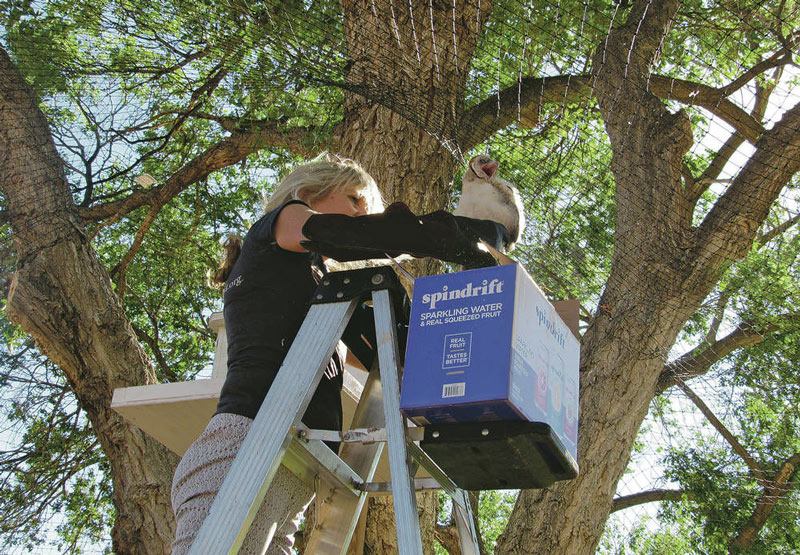
Liz Roberts of Wildlife Rescue Inc. of New Mexico lifts a young barn owl out of its container and into its new abode at Santa Fe (N.M.) Country Club. The organization is working with the golf course to acclimate the owls to their new surroundings so the birds can help the club with its overabundance of prairie dogs. Photo by James Barron
When Liz Roberts saw the barn owls she was transporting to Santa Fe screeching at the sight of her, she couldn’t have been happier. It meant that she had done her job rehabilitating the birds over the past several weeks, because they hadn’t grown accustomed to human contact. They were ready to venture into the wild.
“If they’re standing up, screeching at you, then they fear you,” says Roberts, who rehabilitates barn owls for Wildlife Rescue Inc. of New Mexico. “If they’re like, ‘Oh, hey, she’s here,’ then you’re like, ‘Oh no ...’”
Roberts, founder of the organization that rescues and rehabilitates displaced wildlife, and Penny Elliston, a volunteer with the group, brought a pair of barn owls to their new home last month: Santa Fe (N.M.) Country Club. The owls, which couldn’t yet fly because they were only several weeks old at the time, were transferred to an enclosed owl house built by country club members Alan Hamilton and Tim Conley between the first hole and No. 17.
The owls are at Santa Fe Country Club to provide a more natural way of addressing the decades-old problem of prairie dog overpopulation on the grounds.
The barn owls’ arrival was the culmination of a roughly four-year project that Hamilton and Conley started to find a way to address the prairie dog issue. Because the golf course is in the prairie dog’s natural habitat, they often burrow and dig holes all over the course, which can impact the health of the course’s grass as well as create holes that golfers can step in, possibly injuring themselves.
It became such a huge problem that the course’s board of directors hired a person to focus just on the furry creatures.
Initially, members erected several owl houses around the course to try to attract the birds, but they would find other birds nesting in structures. It wasn’t until Hamilton was with a friend who oversees fruit trees and had had his own battle with prairie dogs that he stumbled upon a potential solution for Santa Fe Country Club.
“He put up some owl boxes, and they just cleaned them out,” Hamilton says.
Still, it took some time for golf course members to make contact with Wildlife Rescue Inc. of New Mexico. It was almost like a game of telephone, Elliston says, in which information trickled from one person to another. “It was like Alan knew this guy, who knew this guy, and he told me about what they were trying to do,” Elliston says.
What Wildlife Rescue Inc. of New Mexico and Santa Fe Country Club members needed, though, was the right owls at the right time.
Elliston says the organization often receives orphaned or injured animals from people they know or from veterinarians who cannot keep them. In the case of barn owls, she says many of the babies Wildlife Rescue receives have fallen out of nests the parents create in high treetops.
“They nest in cavities, high up in these cottonwood holes,” Elliston says. “A lot of times, you have to get the fire department to get them back up there. Otherwise, the parents just don’t pay attention to them. If they get replaced, the parents will take care of them. If they don’t, they’re goners.”
Roberts, who houses a male barn owl, had a group of six owls she was rehabilitating, but they were already at a point in their maturity where they were ready for what she calls a “soft release.” That meant she opened up the doors to the cage they lived in, but they could return if they liked.
Roberts says using those owls would have been pointless, as they’d be more likely to leave the course to find their own habitat. However, she had a pair of barn owls who were young enough to make the transition to a new home.
This is the first time Roberts has transferred owls to a golf course, and she is intrigued by the country club’s project. “These ones are young,” Roberts says. “They’re still trying to acclimate.”
The country club — where 31-year GCSAA member Gary Hodge, CGCS, is superintendent — will use a group of groundskeepers and members to feed the owls in the meantime. When the birds can fly, country club members will take down the netting over the top of their house to allow them to roam freely. The hope is that the nocturnal creatures will find enough food to stay on the course. If it doesn’t work, though, club members and Wildlife Rescue say they are willing to try again next year.
“If we can get a nesting situation going, then that would be great,” Conley says. “I think we can provide a nesting situation, because there are enough animals for them to be able to take for food.”